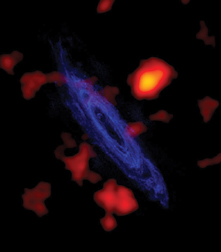It takes a lot of gas to construct a galaxy, but it’s only recently that astronomers have identified what may be gaseous remnants from the Milky Way’s formation. Now, a radio telescope has made the first conclusive observations of gas clouds that could be the leftover building blocks of the Andromeda galaxy, the Milky Way’s nearest galactic neighbor of comparable size.

Large galaxies such as Andromeda and the Milky Way grow in two ways—by gobbling up smaller galaxies and by snaring clouds of hydrogen gas. It’s clouds such as these that David A. Thilker of Johns Hopkins University in Baltimore and his colleagues have now detected swarming around Andromeda. They describe their findings in an upcoming Astrophysical Journal Letters.
A similar collection of clouds, associated with the Milky Way, was first detected in 1963, but astronomers weren’t sure until the mid-1990s how the gas might be linked to our galaxy’s formation (SN: 1/25/97, p. 55). Even then, it remained unclear whether the clouds are pristine remnants of the galaxy’s formation or gas that was incorporated into the Milky Way but then expelled by supernovas.
The Andromeda finding strengthens the case that the high-velocity clouds surrounding the Milky Way include remnant gas from the galaxy’s origin, says Thilker. His team detected 20 clouds of neutral atomic hydrogen around Andromeda by recording faint but telltale radio emissions with the Green Bank (W.Va.) Telescope. Observations with the Westerbork Synthesis Radio Telescope in the Netherlands added to the evidence.
The new observations indicate that the clouds lie too far away from the disk of Andromeda to be material expelled by supernovas within the galaxy, says Thilker.







